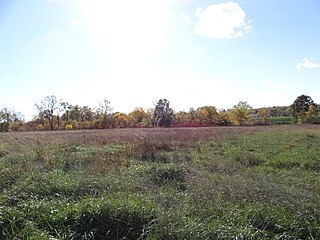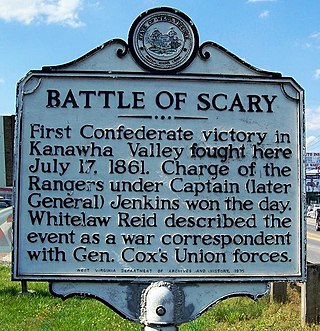
The Battle of Pea Ridge, also known as the Battle of Elkhorn Tavern, took place during the American Civil War near Leetown, northeast of Fayetteville, Arkansas. Federal forces, led by Brig. Gen. Samuel R. Curtis, moved south from central Missouri, driving Confederate forces into northwestern Arkansas. Maj. Gen. Earl Van Dorn had launched a Confederate counteroffensive, hoping to recapture northern Arkansas and Missouri. Confederate forces met at Bentonville and became the most substantial Rebel force, by way of guns and men, to assemble in the Trans-Mississippi. Against the odds, Curtis held off the Confederate attack on the first day and drove Van Dorn's force off the battlefield on the second. By defeating the Confederates, the Union forces established Federal control of most of Missouri and northern Arkansas.
The Battle of Bayou Fourche, also known as the Battle of Little Rock, was a battle of the American Civil War fought between Union and Confederate forces on September 10, 1863, in Pulaski County, Arkansas. It was the final battle of the Little Rock Campaign, resulting in the Federal occupation of Little Rock.

The Battle of Marais des Cygnes took place on October 25, 1864, in Linn County, Kansas, during Price's Missouri Campaign during the American Civil War. It is also known as the Battle of Trading Post. In late 1864, Confederate Major-General Sterling Price invaded the state of Missouri with a cavalry force, attempting to draw Union troops away from the primary theaters of fighting further east. After several victories early in the campaign, Price's Confederate troops were defeated at the Battle of Westport on October 23 near Kansas City, Missouri. The Confederates then withdrew into Kansas, camping along the banks of the Marais des Cygnes River on the night of October 24. Union cavalry pursuers under Brigadier General John B. Sanborn skirmished with Price's rearguard that night, but disengaged without participating in heavy combat.

The Battle of Carthage, also known as the Engagement near Carthage, took place at the beginning of the American Civil War on July 5, 1861, near Carthage, Missouri. The experienced Colonel Franz Sigel commanded 1,100 Federal soldiers intent on keeping Missouri within the Union. The Missouri State Guard was commanded by Governor Claiborne F. Jackson himself and numbered over 4,000 soldiers led by a hero of Mexico, Sterling Price, along with 2,000 unarmed troops who did not participate in the battle.

The siege of Lexington, also known as the first battle of Lexington or the Battle of the Hemp Bales, was a minor conflict of the American Civil War. The siege took place from September 13 to 20, 1861 between the Union Army and the pro-Confederate Missouri State Guard in Lexington, county seat of Lafayette County, Missouri. The victory won by the Missouri Guard bolstered the considerable Southern sentiment in the area, and briefly consolidated Missouri State Guard control of the Missouri River Valley in the western part of the state.

The First Battle of Boonville was a minor skirmish of the American Civil War, occurring on June 17, 1861, near Boonville in Cooper County, Missouri. Although casualties were extremely light, the battle's strategic impact was far greater than one might assume from its limited nature. The Union victory established what would become an unbroken Federal control of the Missouri River, and helped to thwart efforts to bring Missouri into the Confederacy.

The Battle of Belmont was fought on November 7, 1861, in Mississippi County, Missouri. It was the first combat test in the American Civil War for Brig. Gen. Ulysses S. Grant, the future Union Army general in chief and eventual U.S. president, who was fighting Major General Leonidas Polk. Grant's troops in this battle were the "nucleus" of what would become the Union Army of the Tennessee.
The Battle of Prairie D'Ane, also known as the Skirmish at Prairie D'Ane, Battle of Gum Springs, or Battle of Moscow, was fought in present-day Nevada County, Arkansas, as part of the Camden Expedition, during the American Civil War. The Camden Expedition was launched by Union forces as part of the Red River Campaign of 1864. U.S. planners envisioned two federal armies converging simultaneously, one force under the command of Maj. Gen. Nathaniel Banks pressing northward up the Red River commencing at Alexandria, Louisiana and the other federal army under the command of Maj. Gen. Frederick Steele driving southwestward from Little Rock, Arkansas. The objective was to press the rebel army of Gen. E. Kirby Smith back upon the rebel stronghold at Shreveport and defeat him. If successful, a somewhat vague second phase envisioned the two federal armies combining into one large force and continuing their offensive with a westward push into Texas.

The Battle of Athens was an American Civil War skirmish that took place in northeast Missouri in 1861 near present-day Revere and southeast Iowa along the Des Moines River across from Croton. The Union victory has the distinction of being the most northerly of Civil War Battles fought west of the Mississippi, and also of being the only such battle fought along the Iowa border.

The Battle of Droop Mountain occurred in Pocahontas County, West Virginia, on November 6, 1863, during the American Civil War. A Union brigade commanded by Brigadier General William W. Averell defeated a smaller Confederate force commanded by Brigadier General John Echols and Colonel William L. "Mudwall" Jackson. Confederate forces were driven from their breastworks on Droop Mountain, losing weapons and equipment. They escaped southward through Lewisburg, West Virginia; hours before a second Union force commanded by Brigadier General Alfred N. Duffié occupied the town.

The 33rd Illinois Infantry Regiment was an infantry regiment from Illinois that served in the Union Army during the American Civil War. A number of the soldiers were college students and graduates, and for a time the regiment included a 17-piece band. The unit fought at Fredericktown in 1861, Cotton Plant in 1862, the Vicksburg campaign and Fort Esperanza in 1863, and at Spanish Fort in 1865. The original enlistees were mustered out in October 1864 while the veterans and recruits were mustered out in December 1865.
The 2nd Kansas Infantry Regiment was an infantry regiment that served in the Union Army during the American Civil War. Recruited in May 1861, it formally organized on June 20. Sent into Missouri, it participated in several small actions in the Springfield area before fighting in the Battle of Wilson's Creek on August 10, where it suffered 70 casualties out of about 600 men present excluded a detached cavalry company. Ordered back to Kansas after the battle, it fought in several small actions in Missouri and later mobilized in Kansas after enemy forces captured Lexington, Missouri, as Kansas was believed to be threatened by the Lexington movement. The unit was disbanded on October 31, with some of its men, including its commander, joining the 2nd Kansas Cavalry Regiment. Colonel Robert B. Mitchell commanded the regiment until he was wounded at Wilson's Creek and Lieutenant Colonel Charles W. Blair took command.

The Battle of Scary Creek was a minor battle fought on July 17, 1861, during the American Civil War in Scary across the Kanawha River from present day Nitro in Putnam County, West Virginia. It was the first Confederate victory in Kanawha Valley.
Hiram Bledsoe's Missouri Battery was an artillery battery that served in the Missouri State Guard and the Confederate States Army during the American Civil War. The battery was formed when the Missouri State Guard was formed as a pro-secession state militia unit in response to the Camp Jackson affair. As part of the Missouri State Guard, the unit was engaged in the Engagement near Carthage and the Battle of Wilson's Creek during mid-1861, before fighting at the Battle of Dry Wood Creek and the Siege of Lexington later that year when Major General Sterling Price led the Guard northwards towards the Missouri River. After the Missouri State Guard retreated into Arkansas in early 1862, Bledsoe's Battery served during the Confederate defeat at the Battle of Pea Ridge in March. The battery, as part of the Army of the West, transferred across the Mississippi River into Tennessee in April, where it left the Guard to enter Confederate service on April 21.

The 1st Missouri Field Battery was a field artillery battery that served in the Confederate States Army during the American Civil War. The battery was formed by Captain Westley F. Roberts in Arkansas in September 1862 as Roberts' Missouri Battery and was originally armed with two 12-pounder James rifles and two 6-pounder smoothbore guns. The unit fought in the Battle of Prairie Grove on December 7, as part of a Confederate offensive. Roberts' Battery withdrew after the battle and transferred to Little Rock, Arkansas, where Roberts resigned and was replaced by Lieutenant Samuel T. Ruffner.

The Battle of Riggins Hill was a minor engagement in western Tennessee during the American Civil War. A Confederate raiding force under Colonel Thomas Woodward captured Clarksville, Tennessee, threatening Union shipping on the Cumberland River. Several Union regiments led by Colonel William Warren Lowe advanced from nearby Fort Donelson and drove off the Confederates after a struggle lasting less than an hour. The action occurred during the Confederate Heartland Offensive but only affected the local area.
Nichols's Missouri Cavalry Regiment served in the Confederate States Army during the late stages of the American Civil War. The cavalry regiment began recruiting in early 1864 under Colonel Sidney D. Jackman, who had previously raised a unit that later became the 16th Missouri Infantry Regiment. The regiment officially formed on June 22 and operated against the Memphis and Little Rock Railroad through August. After joining Major General Sterling Price's command, the unit participated in Price's Raid, an attempt to create a popular uprising against Union control of Missouri and draw Union troops away from more important theaters of the war. During the raid, while under the command of Lieutenant Colonel Charles H. Nichols, the regiment was part of an unsuccessful pursuit of Union troops who were retreating after the Battle of Fort Davidson in late September.
The Little Rock Campaign, officially known as Advance of the Union forces upon Little Rock, Arkansas, was a campaign conducted by the Union Army in Arkansas during the American Civil War. The strategic offensive was designed to capture Little Rock.
Clark's Missouri Battery was an artillery battery that served in the Confederate States Army during the American Civil War.












